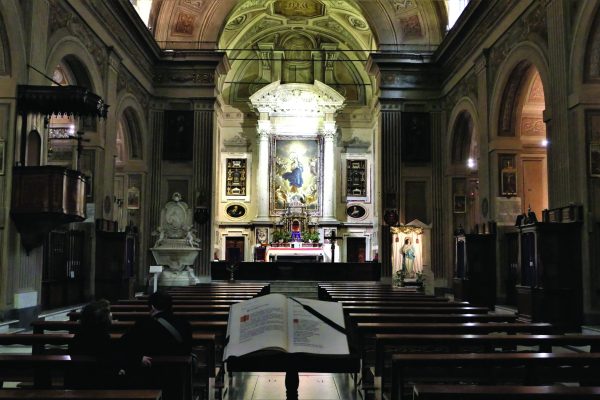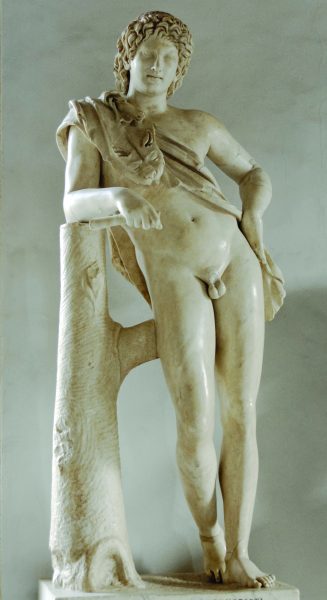Discover more about the Roman inspirations for Nathaniel Hawthorne’s 19th-century Gothic novel with Joe Gartman.

Long ago in Rome, wealthy families often embellished their palazzi with tall, fortified towers. This allowed them to impress rival clans or perhaps dump noxious liquids on their heads when the situation required it. The owners of one such tower kept a pet monkey, an agile and rather mischievous creature. They also had an infant son; and the monkey decided one day to grab the baby and scamper up to the tower’s parapet. The parents were afraid to pursue the animal in case it dropped the boy, and frantically signalled for it to bring the child down; but the monkey, with the infant in its arms, merely grinned and chattered.
Desperate, the parents fell to their knees and earnestly implored the Holy Virgin to save their son; and after a few minutes, the monkey carefully descended and tenderly placed the boy in his mother’s arms. In gratitude, the owners erected a marble statue of the Virgin on the top of the tower, flanked by a lamp, which was to burn continually as long as the tower stood.
Now, you may think this story is merely a legend, but if you go where Via dei Portoghesi and Via dei Pianellari meet, not far from Piazza Navona, and look upwards, you’ll see the tower, with Mary on the edge of the parapet, and the lamp (now containing an electric bulb) beside her. (I asked a local shopkeeper why the lamp was dark, and he said, rather sheepishly, that nowadays it was only lit on Sundays.)
Nathaniel Hawthorne heard the story in Rome in the mid-19th century and recounted it in a book called The Marble Faun. It’s a darkly romantic Gothic novel about four young friends in Rome’s Anglo- American artist colony: Miriam, a painter with a mysterious past, is stalked by an ominous figure who takes various forms; Hilda, who produces copies of famous paintings, lives in the Monkey Tower and tends the flame of the lamp; Kenyon, a sculptor, loves Hilda; and Donatello, an Italian count, is in love with Miriam. Donatello bears a remarkable resemblance to the Faun of Praxiteles, a statue in the Capitoline Museums, and seems to embody the carefree spirit of such woodland creatures. But the evil that stalks Miriam forces all the friends to examine their own souls, when one of them commits murder.

As you might expect from the author of The Scarlet Letter, Hawthorne presents his story of moral dilemmas in such a dramatic way that The Marble Faun became a huge success on both sides of the Atlantic. (Its British title was Transformations.) And, because Hawthorne lived in Rome for a year after finishing a term in Liverpool as the American Consul there, he set the action of the book in many picturesque Roman locations. Tourists who were fans of the story began packing the book in their luggage, in preference to Baedeker, the standard guidebook of the time, so that they could see the sights through their favourite characters’ eyes. For three-quarters of a century, such literary tourists relived the drama of the book in the original settings.
In the Capitoline Museums they could contemplate the Marble Faun himself and wonder whether or not Donatello actually had pointed ears, like the naked satyr; and close by, they could discuss the merits and defects of the Dying Gaul statue, as Miriam and Kenyon had. And in the Capuchin Church on Via Veneto, near Piazza Barberini, they could stand where Donatello and Miriam, to their horror, saw a corpse, of one they knew only too well, begin to bleed. And, of course, the chapels lined with bones were there as well.
In Palazzo Barberini, they would find the famous portrait of Beatrice Cenci, by Guido Reni. (Beatrice, it was said, was repeatedly raped and abused by her father, Count Francesco Cenci. She and her stepmother, two brothers, and a servant, murdered the Count; and when they were caught they were all – except the younger brother – condemned and brutally executed.) The painting was believed to show Beatrice the night before her beheading. Today’s art historians claim the painting is not by Reni and that the girl in the picture isn’t Beatrice. But Hawthorne’s readers, visiting years before the 21st century spoilsports intervened, wouldn’t have known about this; and they could re-live the episode in which Hilda explains to Miriam her obsession with the picture.
In Saint Peter’s Basilica, the waiting confessionals and their multi-lingual priests would have reminded Hawthorne’s readers of Hilda’s fateful confession, and the consequences that followed. On the Appian Way, they’d find the great curving walls of Cecilia Metella’s tomb, where Kenyon journeyed, searching for Hilda after she disappeared. Then, when these 19th-century tourists descended into the Catacombs of San Callisto, as the characters in the novel did, their way would be lit by burning torches, so that among the flickering shadows on the walls they might easily imagine that the ‘Spectre of the Catacomb’ was coming for them, as he did for Miriam.
Of course the more thoughtful travellers who followed the story of the Marble Faun around Rome made sure they visited the Monkey Tower after dusk, so they could reassure themselves that Hilda was still on the job, replenishing the oil in Mary’s lamp. I think the next time I visit the tower, it’ll be on a Sunday evening, and I’ll wait till dark, when I hope Hilda’s ghost will flip the switch.
Enjoyed this article? Read more like it in the Italia archive today!
